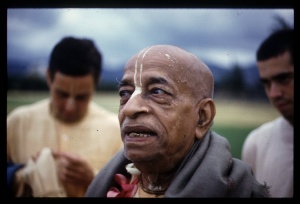CC Madhya 20.339 (1975): Difference between revisions
(Vanibot #0027: CCMirror - Mirror CC's 1996 edition to form a basis for 1975) |
(Vanibot #0020: VersionCompareLinker - added a link to the Version Compare feature) |
||
| Line 2: | Line 2: | ||
<div style="float:left">'''[[Sri Caitanya-caritamrta (1975)|Śrī Caitanya-caritāmṛta (1975)]] - [[CC Madhya (1975)|Madhya-līlā]] - [[CC Madhya 20 (1975)|Chapter 20: Lord Śrī Caitanya Mahāprabhu Instructs Sanātana Gosvāmī in the Science of the Absolute Truth]]'''</div> | <div style="float:left">'''[[Sri Caitanya-caritamrta (1975)|Śrī Caitanya-caritāmṛta (1975)]] - [[CC Madhya (1975)|Madhya-līlā]] - [[CC Madhya 20 (1975)|Chapter 20: Lord Śrī Caitanya Mahāprabhu Instructs Sanātana Gosvāmī in the Science of the Absolute Truth]]'''</div> | ||
<div style="float:right">[[File:Go-previous.png|link=CC Madhya 20.338 (1975)|Madhya-līlā 20.338]] '''[[CC Madhya 20.338 (1975)|Madhya-līlā 20.338]] - [[CC Madhya 20.340 (1975)|Madhya-līlā 20.340]]''' [[File:Go-next.png|link=CC Madhya 20.340 (1975)|Madhya-līlā 20.340]]</div> | <div style="float:right">[[File:Go-previous.png|link=CC Madhya 20.338 (1975)|Madhya-līlā 20.338]] '''[[CC Madhya 20.338 (1975)|Madhya-līlā 20.338]] - [[CC Madhya 20.340 (1975)|Madhya-līlā 20.340]]''' [[File:Go-next.png|link=CC Madhya 20.340 (1975)|Madhya-līlā 20.340]]</div> | ||
{{CompareVersions|CC|Madhya 20.339|CC 1975|CC 1996}} | |||
{{RandomImage}} | {{RandomImage}} | ||
==== TEXT 339 ==== | ==== TEXT 339 ==== | ||
| Line 11: | Line 10: | ||
<div class="verse"> | <div class="verse"> | ||
:ei mantre dvāpare kare kṛṣṇārcana | :ei mantre dvāpare kare kṛṣṇārcana | ||
: | :'kṛṣṇa-nāma-saṅkīrtana'--kali-yugera dharma | ||
</div> | </div> | ||
| Line 18: | Line 17: | ||
<div class="synonyms"> | <div class="synonyms"> | ||
ei mantre—by this mantra; dvāpare—in the | ei mantre—by this mantra; dvāpare—in the age of Dvāpara; kare—perform; kṛṣṇa-arcana—the worship of Lord Kṛṣṇa; kṛṣṇa-nāma-saṅkīrtana—chanting of the holy name of Lord Kṛṣṇa; kali-yugera dharma—the occupational duty in the Age of Kali. | ||
</div> | </div> | ||
| Line 25: | Line 24: | ||
<div class="translation"> | <div class="translation"> | ||
"By this mantra, the people worship Lord Kṛṣṇa in the Dvāpara-yuga. In the Kali-yuga the occupational duty of the people is to chant congregationally the holy name of Kṛṣṇa. | |||
</div> | </div> | ||
| Line 32: | Line 31: | ||
<div class="purport"> | <div class="purport"> | ||
As stated in Śrīmad-Bhāgavatam ([[SB 12.3.51]]): | As stated in Śrīmad-Bhāgavatam ([[SB 12.3.51|12.3.51]]): | ||
:kaler doṣa-nidhe rājann asti hy eko mahān guṇaḥ | :kaler doṣa-nidhe rājann | ||
:kīrtanād eva kṛṣṇasya mukta- | :asti hy eko mahān guṇaḥ | ||
:kīrtanād eva kṛṣṇasya | |||
:mukta-saṅgaḥ paraṁ vrajet | |||
In Kali-yuga one worships Lord Kṛṣṇa by chanting Hare Kṛṣṇa, Hare Kṛṣṇa, Kṛṣṇa Kṛṣṇa, Hare Hare Hare Rāma, Hare Rāma, Rāma Rāma, Hare Hare. To propagate this movement, Lord Kṛṣṇa personally appeared as Lord Caitanya Mahāprabhu. That is described in the following verse. | |||
</div> | </div> | ||
Latest revision as of 13:18, 27 January 2020

A.C. Bhaktivedanta Swami Prabhupada
TEXT 339
- ei mantre dvāpare kare kṛṣṇārcana
- 'kṛṣṇa-nāma-saṅkīrtana'--kali-yugera dharma
SYNONYMS
ei mantre—by this mantra; dvāpare—in the age of Dvāpara; kare—perform; kṛṣṇa-arcana—the worship of Lord Kṛṣṇa; kṛṣṇa-nāma-saṅkīrtana—chanting of the holy name of Lord Kṛṣṇa; kali-yugera dharma—the occupational duty in the Age of Kali.
TRANSLATION
"By this mantra, the people worship Lord Kṛṣṇa in the Dvāpara-yuga. In the Kali-yuga the occupational duty of the people is to chant congregationally the holy name of Kṛṣṇa.
PURPORT
As stated in Śrīmad-Bhāgavatam (12.3.51):
- kaler doṣa-nidhe rājann
- asti hy eko mahān guṇaḥ
- kīrtanād eva kṛṣṇasya
- mukta-saṅgaḥ paraṁ vrajet
In Kali-yuga one worships Lord Kṛṣṇa by chanting Hare Kṛṣṇa, Hare Kṛṣṇa, Kṛṣṇa Kṛṣṇa, Hare Hare Hare Rāma, Hare Rāma, Rāma Rāma, Hare Hare. To propagate this movement, Lord Kṛṣṇa personally appeared as Lord Caitanya Mahāprabhu. That is described in the following verse.